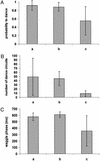Behavioral performance in adult honey bees is influenced by the temperature experienced during their pupal development
- PMID: 12764227
- PMCID: PMC165877
- DOI: 10.1073/pnas.1232346100
Behavioral performance in adult honey bees is influenced by the temperature experienced during their pupal development
Abstract
To investigate the possible consequences of brood-temperature regulation in honey bee colonies on the quality of behavioral performance of adults, we placed honey bee pupae in incubators and allowed them to develop at temperatures held constant at 32 degrees C, 34.5 degrees C, and 36 degrees C. This temperature range occurs naturally within hives. On emergence, the young adult bees were marked and introduced into foster colonies housed in normal and observation hives and allowed to live out their lives. No obvious difference in within-hive behavior was noted between the temperature-treated bees and the foster-colony bees. However, when the temperature-treated bees became foragers and were trained to visit a feeder 200 m from the hive, they exhibited clear differences in dance performance that could be correlated with the temperatures at which they had been raised: bees raised at 32 degrees C completed only approximately 20% of the dance circuits when compared with bees of the higher-temperature group. Also, the variance in the duration of the waggle phase is larger in 32 degrees C-raised bees compared with 36 degrees C-raised bees. All other parameters compared across all groups were not significantly different. One-trial learning and memory consolidation in the bees raised at different temperatures was investigated 1 and 10 min after conditioning the proboscis-extension reflex. Bees raised at 36 degrees C performed as expected for bees typically classified as "good learners," whereas bees raised at 32 degrees C and 34.5 degrees C performed significantly less well. We propose that the temperature at which pupae are raised will influence their behavioral performance as adults and may determine the tasks they carry out best inside and outside the hive.
Figures


Similar articles
-
Synaptic organization in the adult honey bee brain is influenced by brood-temperature control during pupal development.Proc Natl Acad Sci U S A. 2004 Mar 23;101(12):4268-73. doi: 10.1073/pnas.0400773101. Epub 2004 Mar 15. Proc Natl Acad Sci U S A. 2004. PMID: 15024125 Free PMC article.
-
Pupal developmental temperature and behavioral specialization of honeybee workers (Apis mellifera L.).J Comp Physiol A Neuroethol Sens Neural Behav Physiol. 2009 Jul;195(7):673-9. doi: 10.1007/s00359-009-0442-7. Epub 2009 Apr 24. J Comp Physiol A Neuroethol Sens Neural Behav Physiol. 2009. PMID: 19390855
-
The effects of age on olfactory learning and memory in the honey bee Apis mellifera.Neuroreport. 1997 Feb 10;8(3):789-93. doi: 10.1097/00001756-199702100-00042. Neuroreport. 1997. PMID: 9106768
-
Juvenile hormone, behavioral maturation, and brain structure in the honey bee.Dev Neurosci. 1996;18(1-2):102-14. doi: 10.1159/000111474. Dev Neurosci. 1996. PMID: 8840089 Review.
-
Nutritional regulation of division of labor in honey bees: toward a systems biology perspective.Wiley Interdiscip Rev Syst Biol Med. 2010 Sep-Oct;2(5):566-576. doi: 10.1002/wsbm.73. Wiley Interdiscip Rev Syst Biol Med. 2010. PMID: 20836048 Review.
Cited by
-
Trade-off between thermal tolerance and insecticide resistance in Plutella xylostella.Ecol Evol. 2015 Jan;5(2):515-30. doi: 10.1002/ece3.1380. Epub 2015 Jan 6. Ecol Evol. 2015. PMID: 25691976 Free PMC article.
-
Synaptic organization in the adult honey bee brain is influenced by brood-temperature control during pupal development.Proc Natl Acad Sci U S A. 2004 Mar 23;101(12):4268-73. doi: 10.1073/pnas.0400773101. Epub 2004 Mar 15. Proc Natl Acad Sci U S A. 2004. PMID: 15024125 Free PMC article.
-
Temperature-dependent developmental plasticity of Drosophila neurons: cell-autonomous roles of membrane excitability, Ca2+ influx, and cAMP signaling.J Neurosci. 2007 Nov 14;27(46):12611-22. doi: 10.1523/JNEUROSCI.2179-07.2007. J Neurosci. 2007. PMID: 18003840 Free PMC article.
-
Long-Distance Transportation Causes Temperature Stress in the Honey Bee, Apis mellifera (Hymenoptera: Apidae).Environ Entomol. 2019 Jun 7;48(3):681-701. doi: 10.1093/ee/nvz027. Environ Entomol. 2019. PMID: 30927358 Free PMC article.
-
Robustness of the honeybee neuro-muscular octopaminergic system in the face of cold stress.Front Physiol. 2022 Sep 27;13:1002740. doi: 10.3389/fphys.2022.1002740. eCollection 2022. Front Physiol. 2022. PMID: 36237520 Free PMC article.
References
-
- Hess, W. R. (1926) Z. Vgl. Physiol. 4, 465-487.
-
- Himmer, A. (1927) Erlanger Jb. Bienenkunde 5, 1-32.
-
- Seeley, T. D. (1985) Honeybee Ecology, A Study of Adaptation in Social Life (Princeton Univ. Press, Princeton).
-
- Seeley, T. D. (1995) The Wisdom of the Hive (Harvard Univ. Press, Cambridge, MA).
-
- Southwick, E. E. & Heldmaier, G. (1987) Bioscience 37, 395-399.
Publication types
MeSH terms
LinkOut - more resources
Full Text Sources
Miscellaneous

